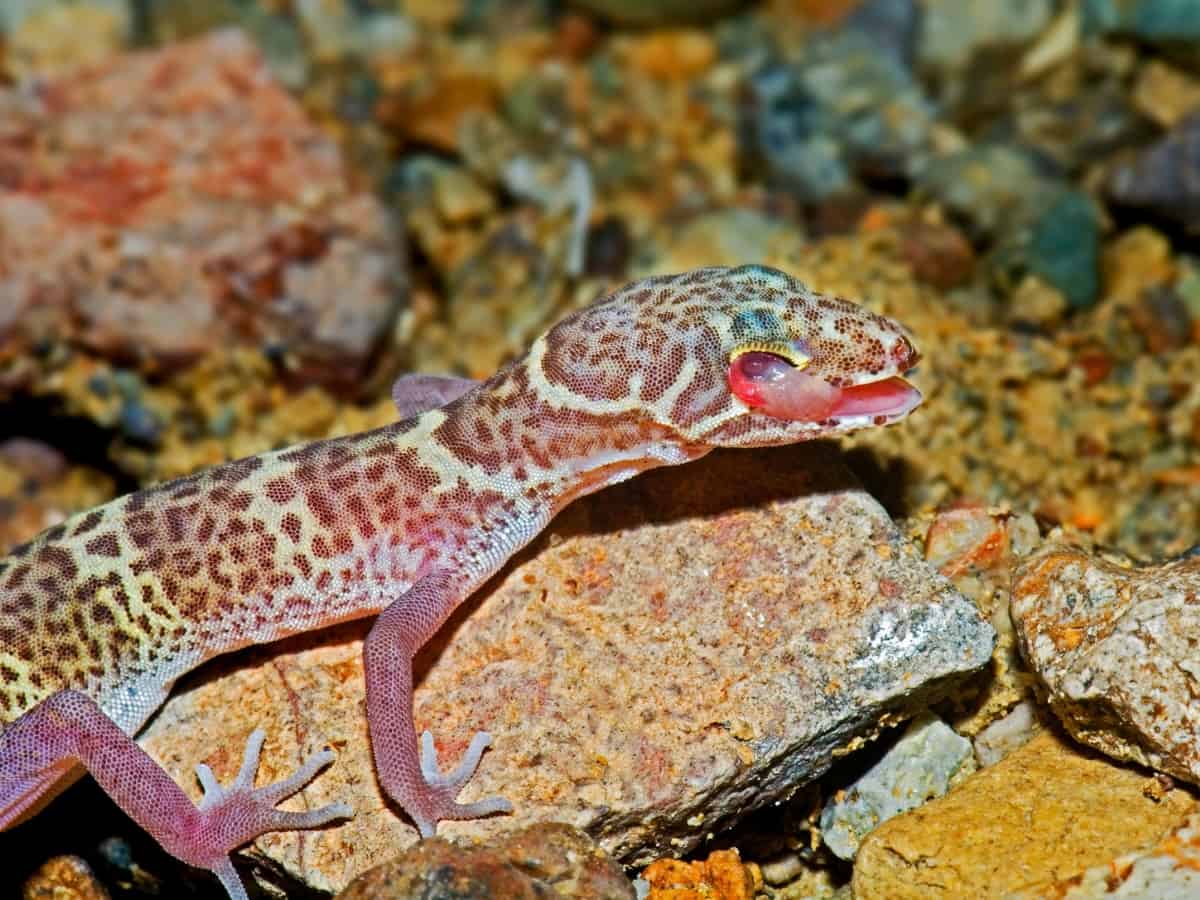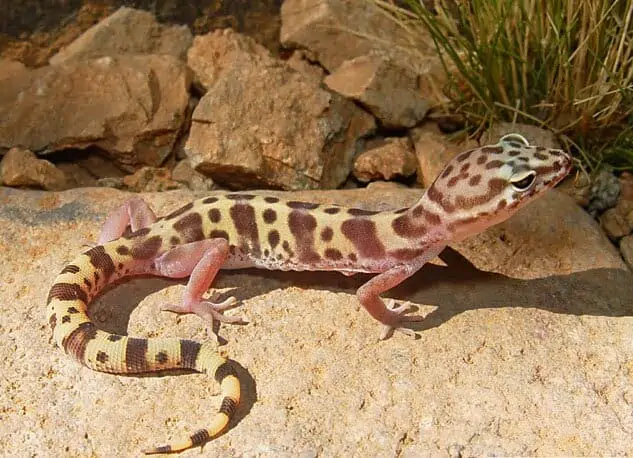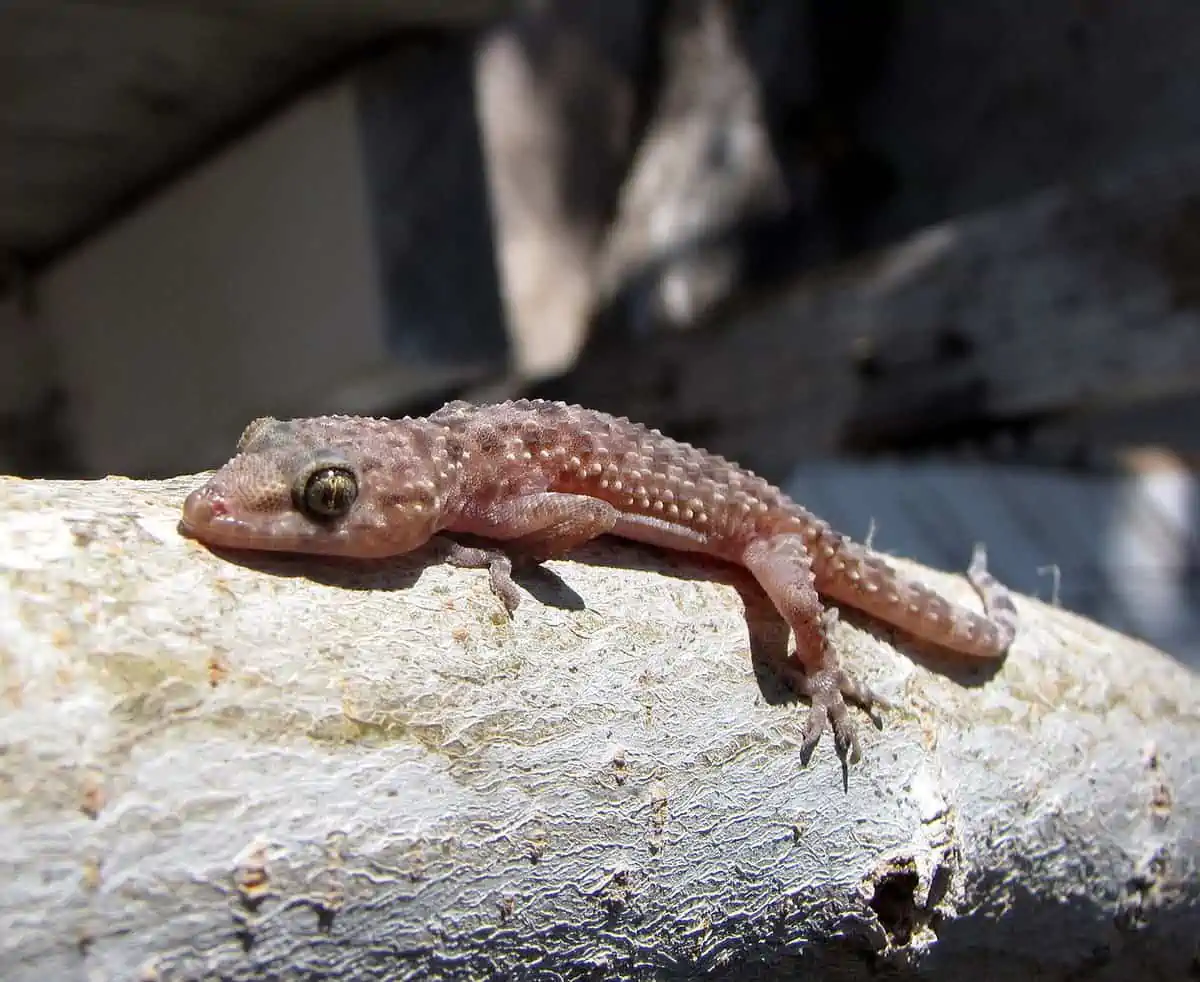Share the post "Geckos of Texas (6 Native and Invasive)"
It’s no secret that Texas houses many reptiles, and geckos are among the common reptiles you can keep an eye out for!
When thinking about the geckos of Texas, you’ll usually find six common species. Each species has some distinctive structural characteristics, like its size, color, and skin coverings. Keep on reading this article to learn about all the details!

Native Geckos of Texas
You might be surprised to learn that the Lone Star State harbors only two native gecko species: the Texas-banded gecko and the reticulate-banded gecko. You may also find western-banded geckos. All three species belong to the genus Coleonyx.
The last-mentioned variety, however, is native to the southwestern USA and isn’t exactly Texas-specific.
Look closely at each species’ description, distribution, and behavior!
1. Texas-Banded Gecko
The Texas-banded geckos (Coleonyx brevis) are one of the smallest lizards found in America. Juveniles usually have a length of 1.75 inches, which increases to around four inches when they become adults.
Female texas-banded geckos are slightly larger than males, all of which have a nearly equal tail-to-body ratio.
Covering their slender bodies are pinkish-brown scales with alternating brown and pale yellow bands. These small geckos have large heads and big eyes with movable eyelids.
What distinguishes Texas-banded geckos is the distinctive black speckling covering them. Plus, they lack prominent tubercles, which are the small round outgrowths found on the skin and pads on their slender toes.
You can find those spotty geckos in southern and western Texas, where the climate is arid or semi-arid. They usually seek shelter during the day under rocks and other small openings. They hunt at night as well.
Interestingly, Texas-banded geckos cut off their wiggling tails when sensing danger to distract the predators. This is a defense mechanism found in most geckos. Additionally, they produce high-pitched screeches to scare threatening animals away.
2. Reticulate-Banded Gecko
Another Texian lizard that belongs to the banded group is the reticulate-banded gecko (Coleonyx reticulatus). Unlike Texas-banded geckos, reticulated geckos are relatively large, reaching an adult length of 6.5 inches. Still, females are larger than males in this species.
You can easily mistake them for their smaller banded cousins, leopard geckos. That’s because they have tan ground color covering their skin with brown, pink, and black spots, and movable eyelids. Plus, they also lack toe pads.
However, this slightly larger gecko displays faint or no banding, unlike Texas-banded geckos.
Tubercles help you distinguish between the two banded geckos. You’ll usually find 13 rows of enlarged skin outgrowth on reticulated-banded geckos. In addition, the tubercles rows irregularly cover their backs.
Similar to their banded relative, this Texian reticulated gecko is nocturnal and prefers semi-arid, rocky areas. It also shows the same tail-cutting and screaming defense mechanism when threatened.

3. Western-Banded Gecko
The western-banded gecko (Coleonyx variegatus) lives in southwestern states, but you can also see it in Texas. Like Texas-banded geckos, the western-banded variety has a slender body and big eyes with movable eyelids. However, it lacks toe pads and enlarged tubercles on their skin.
Still, you can differentiate between each gecko by its length. Western-banded geckos are larger, reaching four to six inches in adulthood.
Aside from size, skin color can also help you distinguish western-banded geckos from the other two Texian geckos. Their base color is usually creamy yellow, and their limbs are slightly pink.
Almost all western-banded juveniles have distinctive bands covering their bodies. As for the adults, they contain continuous broad banding or large spots, which are reddish-brown or a mix of both.
It comes as no surprise that the yellow-colored gecko is nocturnal and prefers warm weather. They live under rocks, in pinyon-juniper woodlands, sagebrush, and other habitats.
Invasive Geckos In Texas
Interestingly, most geckos you can find creeping into your house are non-native! Mediterranean house geckos, common house geckos, and rough-tailed geckos are the most common invasive geckos present in Texas.
The former two are of the genus Hemidactylus, while the latter belongs to the genus Cyrtopodion.
1. Mediterranean House Geckos
As the name implies, Mediterranean house geckos (Hemidactylus turcicus) originate from the Mediterranean region, but they’re widely distributed around the world.
They’re abundant in southern Texas, as a result of the warm, dry climate present in that region. It’s believed those non-native lizards came to the Lone Star State as hitchhikers on cargo ships.
These colonizers are small, measuring between four to five inches. They’re mainly purplish-tan and have black spots. However, their bodies can be entirely translucent with dark speckling. The tail is usually striped with brown bands.
Unlike the banded geckos, these non-native species have sticky padded toes. They also lack eyelids. Plus, you can notice small and large tubercles, regularly arranged in 14 to 16 rows along the entire body.
As you can tell from their wide geographical distribution, Mediterranean house geckos live in many habitats. From coastal regions, rocks, old buildings, cliffs, caves, and even trash piles, those pesky house visitors are comfortable anywhere.

2. Common House Geckos
At maturity, common house geckos (Hemidactylus frenatus) measure between three to six inches. Similar to their Mediterranean cousins, common house geckos have toe pads and no eyelids. However, they lack tubercles on their backs.
As for their color, these unwanted house guests are pink to gray, with some dark spots marbling their smooth skin.
Originally from south and southeast Asia, those non-native geckos prefer urban areas and tropical climates. You’ll usually find them near the light to hunt for insects.
3. Rough-Tailed Geckos
Although they originate from the Middle East, you can find rough-tailed geckos in Texas, mainly in Galveston.
Rough-tailed geckos are easily distinguishable from other non-native geckos in Texas. They’re small, reaching between three to 4.6 inches long.
Unlike the smooth house geckos, this middle eastern gecko has keeled scales covering its body. Plus, they don’t have padded toes. Instead, they’re long, thin, and clawed. When it comes to their color, those spiny geckos are sandy.
Like most geckos, they’re nocturnal and feed on insects.
Why Are There So Many Geckos In Texas?
Several reasons make Texas a convenient home for most geckos. Mostly, this has to do with the weather. Generally, geckos grow in tropical, arid, and semi-arid climates, all of which are found in different regions of Texas.
What’s more, those small lizards feed primarily on insects. Thanks to its geographical position and size, Texas houses about a third of all insect species found in the USA. That explains why geckos find the Lone Star State tempting.
References
- Banded geckos: reptile-database.reptarium.cz
- House geckos: citybugs.tamu.edu
- Rough-tailed gecko: californiaherps.com
Share the post "Geckos of Texas (6 Native and Invasive)"
Christian Linden is a seasoned writer and contributor at Texas View, specializing in topics that resonate with the Texan community. With over a decade of experience in journalism, Christian brings a wealth of knowledge in local politics, culture, and lifestyle. He holds a Bachelor's degree in Communications from the University of Texas. When he's not writing, Christian enjoys spending weekends traveling across Texas with his family, exploring everything from bustling cities to serene landscapes.











